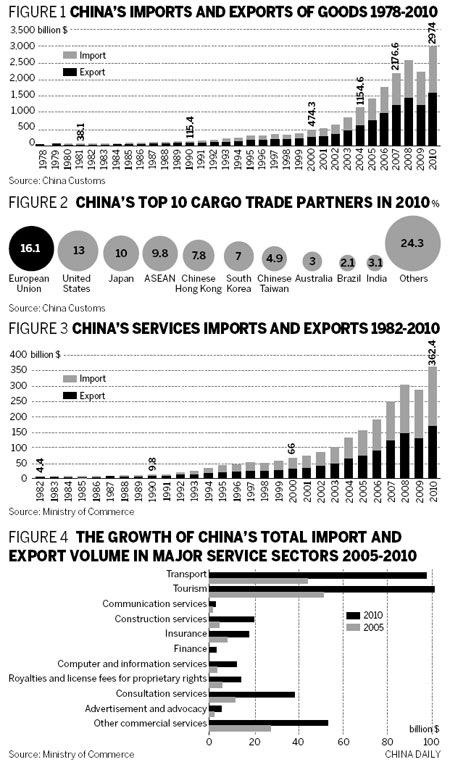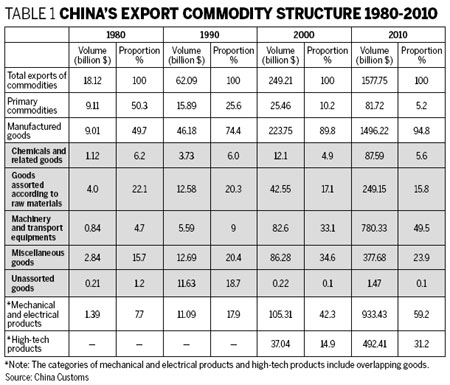Historic progress in China's foreign trade
Updated: 2011-12-08 10:58
(China Daily)
|
|||||||||||
After the founding of the People's Republic of China (PRC) in 1949, China adhered to the principle of independence and self-reliance, and gradually carried out economic and trade exchanges with foreign countries. However, hindered by the international political environment at that time and the country's planned economic system, China's foreign trade development was relatively slow.
In 1978 China entered the new period of reform and opening up. Devoting major efforts to the development of foreign trade became an important approach to accelerate modernization, shake off backwardness, promote the growth of the economy, and improve comprehensive national strength. Over the past 30 years or so, seizing the opportunity of the world economy's long-term prosperity and the deepening economic globalization, China has opened wider to the outside world, attracted and utilized foreign investment, introduced advanced technology, transformed and upgraded domestic industries, and achieved rapid development in foreign trade through all-round participation in the international division of labor and competition.
China's total trade volume in goods ranks high globally.

In 1978 the total value of China's imports and exports was only $20.6 billion, ranking 32nd in world trade and accounting for less than 1 percent of the world's total. In 2010 the total value of China's import and export reached $2.974 trillion, 144 times as much as that in 1978, averaging an annual growth of 16.8 percent. In 2010 the total value of China's exports was $1.5778 trillion, showing a 17.2 percent annual growth on average, and the total value of its imports was $1.3962 trillion, showing a 16.4 percent annual growth on average. In 2010, the total volumes of China's export and import accounted for 10.4 percent and 9.1 percent of the world's total, respectively. By the end of 2010 China had been the world's largest exporter and second-largest importer for two consecutive years.
The structure of China's trade in goods has fundamentally changed.

China's export commodity structure shifted from primary products dominated to manufactured goods dominated in the 1980s, and from mainly light industrial and textile products to mainly mechanical and electronic products in the 1990s. In the new century, China's exports of high-tech products, led by electronics and information technology commodities, has been increasingly expanding. In addition to state-owned enterprises, foreign-invested enterprises and private enterprises also engage in foreign trade, and their total value of imports and exports has each exceeded that of the state-owned enterprises. From the 1980s to the early 21st century, China's processing trade flourished, accounting for half of the country's foreign trade volume. Throughout China's foreign trade development, foreign-invested enterprises and processing trade have played very significant roles.
China has formed an all-round and diversified import and export market.
Since the adoption of the reform and opening up policy, China has been promoting foreign trade on all fronts, and established trade relations with the vast majority of the world's countries and regions. China's trade partners have increased from a small number of countries and regions in 1978 to 231 countries and regions now. The European Union (EU), the United States, the Association of Southeast Asian Nations (ASEAN), Japan, and the other BRIC countries have become China's major trade partners. In this new century China's trade with newly emerging markets and developing countries has maintained a sustained and relatively rapid growth. In China's total trade in goods from 2005 to 2010 the proportion of trade with ASEAN increased from 9.2 percent to 9.8 percent, with other BRIC countries from 4.9 percent to 6.9 percent, with Latin America from 3.5 percent to 6.2 percent, and with Africa from 2.8 percent to 4.3 percent.
China's international competitiveness in services trade has been enhanced.
With its WTO entry, China's trade in services entered a new stage of development. With its scale rapidly enlarged and its pattern gradually optimized, China's trade in services now ranks among the top in the world. China's trade in tourism, transport and other fields has maintained a steady growth momentum. China's cross-border services in construction, communications, insurance, finance, computers and information, royalties and license fees, consultation and related fields, as well as service outsourcing, have been growing rapidly. From 2001 to 2010 China's total services trade value (excluding government services) witnessed a more-than-five-fold growth from $71.9 billion to $362.4 billion. China's proportion in world services trade exports rose from 2.4 percent to 4.6 percent, worth $170.2 billion in 2010, and jumped from the 12th place in the world to the 4th; China's proportion in world services trade imports increased from 2.6 percent to 5.5 percent, worth $192.2 billion in 2010, moving from the 10th place in the world to the 3rd.
China's foreign trade development has greatly pushed forward the country's modernization drive. China has grown into an open economy. Participation in the international division of labor and competition, introduction of advanced technology, equipment and management methods, and utilization of foreign direct investment have greatly promoted China's technological progress and industrial upgrading, and also improved the management and market competitiveness of its enterprises. The rapid growth of processing trade has brought into play China's comparative advantage of an abundant labor force, and accelerated the country's industrialization and urbanization. Foreign trade has directly contributed to the employment of over 80 million Chinese people, more than 60 percent of whom are from rural areas, and employees' income and living standards have been remarkably improved. Foreign trade, domestic investment and domestic consumption have become the three major engines propelling China's economic growth.
The historic progress in China's foreign trade has been closely connected with the changes in the international and domestic situations. Starting in the 1980s, peace and development became the theme of the times. With the acceleration of economic globalization, the flow and allocation of capital, technology, products, markets, resources, labor force and similar elements became more dynamic around the world. Scientific and technological progress, led by information and communications technology, has greatly improved production efficiency; international industrial transfer has continuously deepened and developed. Economic globalization, scientific and technological progress, international industrial transfer and strengthened cooperation between countries have provided historic opportunities for China's integration into the world economy. The Chinese government, conforming to the trend of the times and taking economic construction as the central task, has implemented the reform and opening up policy, developed economic and technological cooperation with other countries, vigorously and rationally utilized foreign investment, brought its comparative advantage into full play, promoted the deepening of the division of labor in the international industrial chain, and provided favorable conditions for its own foreign trade development. During this process foreign enterprises, and multinational corporations in particular, have obtained abundant opportunities to invest in China, added value to their capital, technology, management experience, marketing channels and other elements, and shared the fruits of China's rapid economic growth. China's foreign trade development has benefitted greatly from its reform and opening up, from economic globalization, and from taking the path of cooperation and mutual benefit. China cannot develop in isolation from the rest of the world, and global prosperity and stability cannot be maintained without China's participation.
China remains a developing country. Compared with other world trade powers, China's export industry remains at the low end of the global industrial chain. China's resource and energy inputs and environmental cost are relatively high, while the international competitiveness of enterprises and the risk-resistance of some industries are relatively weak. China's transformation from a large trading country to a strong trading power will be a comparatively long-term process requiring arduous efforts.








